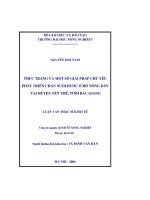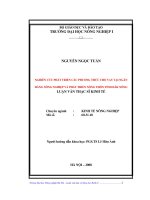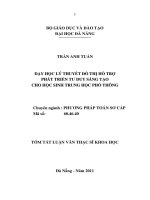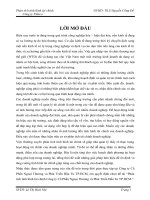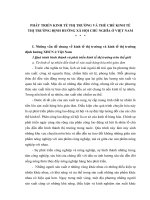Tài liệu phát triển tư duy IQ ôn thi ngân hàng
Bạn đang xem bản rút gọn của tài liệu. Xem và tải ngay bản đầy đủ của tài liệu tại đây (650.28 KB, 224 trang )
i
HOW TO PASS
ADVANCED
NUMERACY
TESTS
ii
‘A wealth of relevant practice questions and detailed explanations to help candidates prepare.’
Sunday Citizen
‘Questions of a similar level to those in real numeracy tests and
so well worth buying.’
A reader review
‘Better than many comparable books on the market for graduate
tests.’
A reader review
iii
HOW TO PASS
ADVANCED
NUMERACY
TESTS
Improve your scores in numerical reasoning
and data interpretation psychometric tests
Revised edition
MIKE BRYON
London and Philadelphia
iv
Whilst the author has made every effort to ensure that the content of this book is
accurate, please note that occasional errors can occur in books of this kind. If you
suspect that an error has been made in any of the tests included in this book, please
inform the publisher at the address printed below so that it can be corrected at the next
reprint.
First published in 2002
Reprinted 2004, 2005, 2006, 2007 (twice)
Revised edition 2008
Apart from any fair dealing for the purposes of research or private study, or criticism or
review, as permitted under the Copyright, Designs and Patents Act 1988, this publication
may only be reproduced, stored or transmitted, in any form or by any means, with the prior
permission in writing of the publishers, or in the case of reprographic reproduction in accordance with the terms and licences issued by the CLA. Enquiries concerning reproduction
outside these terms should be sent to the publishers at the undermentioned addresses:
120 Pentonville Road
London N1 9JN
United Kingdom
525 South 4th Street, #241
Philadelphia PA 19147
USA
www.koganpage.com
© Mike Bryon, 2002, 2008
The right of Mike Bryon to be identified as the author of this work has been asserted by
him in accordance with the Copyright, Designs and Patents Act 1988.
ISBN 978 0 7494 5229 2
British Library Cataloguing in Publication Data
A CIP record for this book is available from the British Library.
Library of Congress Cataloging-in-Publication Data
Bryon, Mike.
How to pass advanced numeracy tests : improve your scores in numerical reasoning and
data interpretation psychometric tests / Mike Bryon. – rev. 1st ed.
p. cm.
ISBN 978–0–7494–5229–2
1. Numeracy—Problems, exercises, etc. 2. Mathematical ability—Problems, exercises,
etc. 3. Psychometrics. 4. Employment tests. I. Title.
QA141.B733 2008
510.76--dc22
2008008247
Typeset by Saxon Graphics Ltd, Derby
Printed and bound in Great Britain by MPG Books Ltd, Bodmin, Cornwall
v
Contents
Acknowledgements
vii
Part 1 Psychometric tests and practice
1
1
Demonstrate your true potential
How this book will help 3; The challenge of
numerical tests 4; What are psychometric tests? 4;
What to expect on the day 5; Interpreting your
score 5
3
2
The winning approach
Key stages to a winning approach 8
7
Part 2 Hundreds of really relevant practice questions
15
3
Quantitative reasoning
Practice questions – revise the basics 17
17
4
Data interpretation
43
5
Business judgement and data sufficiency
Business judgement 75; Data sufficiency 90
75
6
Mock tests
Mock test 1 129; Mock test 2 143;
Mock test 3 159; Mock test 4 167
129
vi
Contents
Part 3 Answers and many detailed explanations
185
Answers and explanations
Chapter 3 Quantitative reasoning 187; Chapter 4
Data interpretation 192; Chapter 5 Business
judgement and data sufficiency 197;
Mock test 1 203; Mock test 2 205;
Mock test 3 207; Mock test 4 208
187
Further reading from Kogan Page
213
vii
Acknowledgements
I owe thanks to Carla Valerio-Chapperon, Miriam Walfisz and
Ed Hateley for contributing many practice questions and
checking answers. Their contributions make the title a far better
book and I trust more valuable as a source of practice. The views
expressed and any errors are entirely my own.
viii
THIS PAGE IS INTENTIONALLY LEFT BLANK
1
Part 1
Psychometric tests and
practice
2
3
1
Demonstrate your true
potential
How this book will help
This book provides highly relevant practice questions and explanations that will help candidates prepare for psychometric tests of
numerical skills.
Many readers of the existing Kogan Page list of testing books
have requested more practice numerical questions and more challenging material than is currently available. In response, this title
offers many hundreds of new questions, including four realistic
mock tests relevant to numerical skills tests used by employers
and educational institutions today.
Like a real test, each chapter starts with easier questions that
get progressively harder. Again, in response to readers’ requests,
many more detailed explanations to answers have been provided.
4
Psychometric tests and practice
The challenge of numerical tests
Employers’ numerical tests represent a considerable challenge to
candidates who have specialized in numerical disciplines, let alone
those who have not. Often accomplished individuals may not have
practised their numerical skills for some years and need to revise
them if they are to present themselves as the all-round candidate
who possesses both numerical and verbal competencies.
Even if you feel confident with your numerical skills, these
exercises will help you to achieve, as psychometric tests are used
to recruit to many top jobs, careers and professions and there is
considerable competition amongst many candidates. You have to
be at your very best if you are to succeed in your chosen career,
and only practice will ensure that you maximize the advantage
you enjoy over others.
What are psychometric tests?
The user of this book is likely to face a psychometric test in
relation to their work or study. Many readers will have applied
for a job or course of study and found that the process involves
them taking a test. In this context psychometric tests are used by
the institution or employer for selection purposes.
The tests comprise a standardized series of problems, either
multiple choice or short-answer, taken with either pen and paper,
at a computer terminal or, increasingly, online. The conditions
under which the test is taken will be the same for everyone. Strict
time limits are likely to apply and the results will be marked or
scored in a way that allows comparisons to be drawn between
candidates. At the graduate and professional end of the testing
spectrum they are likely to be tests of endurance lasting many
hours. They comprise a series or battery of tests sat one after the
other. It is therefore all the more important for candidates to
adopt strategies to maximize their score.
Demonstrate your true potential
5
What to expect on the day
Think back to the days of examinations at school or university.
You will attend a test centre with a room set out either as an examination hall with small desks or with banks of computer terminals,
depending on whether you face a paper and pen or computer
administered version of the test.
Other candidates are very likely to be present. In some instances
there may be many other candidates. A test administrator will
welcome you and explain the process. He or she will be following a
prepared script and will be happy to answer any questions that you
may have, although the answers given may seem rather brief or
superficial. The administrator will be reluctant to stray far from the
script so that all candidates (including those who have attended on
other days and will not have heard your question) receive the same
information and experience the same test conditions.
If you suffer a disability that may affect your performance in the
test or requires you to sit the test under different circumstances,
contact the organization that has invited you straightaway.
Interpreting your score
The scoring of tests is quite complex and individuals responsible
for the interpretation of results should be trained to a level recommended by the British Psychological Society. Scoring involves
comparing a candidate’s score against the scores of a sample of
the wider population with broadly similar backgrounds.
Unsurprisingly, there is a tendency among recruiters to assume
that the higher a candidate scores, the greater the candidate’s
likely performance in the job. Equally common is the tendency
for the recruiter to be relieved that poor-scoring candidates,
whom the test predicts will not perform well in the job, have been
identified in such a clear-cut way.
However, doing well or badly in a test does not necessarily
mean that you have or do not have the potential to perform well
in a particular job. Tests are at best only indicators of potential.
6
Psychometric tests and practice
Had you been less nervous or better prepared on the day of the
test then you might have realized a considerably different score
and been classified quite differently. Performance in the majority
of jobs is a difficult thing to define and is influenced by a wide
range of factors. The occupational psychologist must attribute to
the job in question a single set of criteria against which to assess
performance, and this risks attributing to the workplace too
simplistic a model of what makes someone good at his or her job.
If you fail a test it does not mean that you do not have the
potential to do the job or pursue the career. You may be perfectly
able to do the job and indeed would pass the test if you took it
again. Ask the organization to provide you with feedback on your
score. Some organizations are happy to do this and their
comments will help you to identify any areas in which you need to
improve. Try to recall and note down the types of question and
the level of difficulty. Plan a new programme of practice and
concentrate your efforts on improving your skills in the areas in
which you did least well.
Hundreds more practice questions and tests are available in
the companion title The Advanced Numeracy Test Workbook.
Additional advance material is also available in the Graduate
Psychometric Test Workbook. Both titles are published by
Kogan Page.
7
2
The winning approach
The ability to do well in a test is not some innate quality over
which you have no influence. Your score is to a large extent
dependent on your approach on the day and the degree to which
you are prepared for the challenge.
How you approach a test is critical to success. It is important
that you treat it as an opportunity to demonstrate your true
potential. Avoid feelings of resentment or a fear of failure
whereby you commit less than your full worth. If passing the test
means that you can realize a life goal then you have every reason
to try your best and attend fully prepared.
Studies have shown that the difference between the soloist in
an orchestra, the top athlete or chess grandmaster and the rest is
often down to practice, practice, practice. The key is to stretch
yourself and not simply repeat tasks you can already do easily.
Practice before a test is essential and can make a significant
difference to your performance. Practice makes a difference in
many types of test, including numerical tests. It is obvious that
practice will help because it means you are likely to make fewer
mistakes and are faster against the often-tight time constraints.
Importantly, practice allows you to revise forgotten rules and
develop a good test technique. This involves becoming familiar
with the format of the questions and maximizing your score
through, for example, educated guessing.
8
Psychometric tests and practice
Remember, when used as a part of a selection process you
should treat a psychometric test like a competition in which you
must do better than other candidates. If passing the test is
important then you should be prepared to make a major
commitment in terms of practice before the real test, starting as
soon as possible. Other candidates will make such a commitment
and if you don’t, you risk coming a poor second.
Key stages to a winning approach
Under the two headings ‘Work harder’ and ‘Work smarter’ below,
there are eight sections offering advice and tips on the best
approach to adopt when preparing for a psychometric test.
Work harder
Make time for practice
Given that you use your time sensibly and that you work in a way
which reduces your weaknesses and maximizes your strengths, the
amount of time you can devote to intelligent, directed practice will
be crucial. You have already decided that this test is important to
you, so you need to make sure you find time to do yourself justice
and to demonstrate your potential. Those who succeed are often
those with the greatest desire, the greatest tenacity.
Start your practice as soon as you suspect you might have a test
(though you should make sure you are working on the right kind of
exercise – see ‘Work smarter’ below). Try to place yourself somewhere on a scale between someone reasonably confident about
numeracy tests and someone whose numerical skills are very rusty.
If you fall within these bounds then the amount of practice you
need to undertake is likely to lie somewhere between a minimum of
12 hours and putting aside a few hours a day for three or four
weeks. Plan your practice right up to the day of the test, but try
to leave yourself a little margin in case you underestimate the
challenge and need more time than you initially allowed.
The winning approach
9
Work smarter
Decide how to practise
Everyone can improve his or her test score with practice and the
more you practise something you find challenging the better you
will do. However, the optimum amount of practice depends on
your starting point. For example, the candidate who is otherwise
likely to fail by only a few marks stands to gain a lot very quickly
because a little practice is almost certain to mean that they pass
something they would otherwise have failed. Someone who has
not used their numerical skills for some years will need to relearn
the rules and regain their lost speed and accuracy before they can
demonstrate their true potential. This may require a quite considerable commitment. A candidate who never got on with maths or
science at school and specialized at university in an arts subject
may need to commit many weeks of effort to master skills they
had previously managed without. Be clear about what you need
to practise and make time to do it.
Start your programme of practice in good time
Try to place yourself somewhere on a scale between reasonably
confident and someone whose numerical skills are very rusty. If
you fall within these bounds then the amount of practice you
need to undertake is likely to lie between a minimum of 12 hours
and putting aside a few hours a day for three or four weeks.
It is best to practise up to the day before the test. But try to
leave yourself a little scope in case you underestimate the challenge and need more time than you initially allowed.
Be clear as to the type of test you face
Improvements in scores are obtained by practising on material
similar to that which occurs in the real test. It is essential,
therefore, that you establish the types of question you face and
find material as similar as possible. The organization might have
sent you a description of the test or have a website that contains a
number of sample questions. If this is not the case, call them and
request a description of the test and as much information as
10
Psychometric tests and practice
possible. Every bit of information helps, so try requesting a verbal
description over the telephone or simply ask them to list the titles
of the sub-tests that make up the battery and the name of the
publisher. Establish if the test is administered with paper and pen
or at a computer terminal, for how long you need to attend and
whether or not a calculator is provided. Be aware of the fact that
sample questions are usually less difficult examples of the type of
question contained in the real test.
Plan to undertake two sorts of practice:
1.
2.
Practice without time constraint and in an informal relaxed
situation. The aim of this sort of practice is that you realize
the demands of the questions and the mathematical principles behind them and build up your confidence. It is fine to
work collaboratively with someone who also faces the test
or a mentor willing to help.
If your maths is weak or rusty then this type of practice will
form the bulk of your efforts. Make sure that you practise
both on realistic questions and on the content of some of the
very good revision study guides and textbooks that are
available for GCSE and A-level students, for example.
Practice on realistic questions against a strict time constraint
and under realistic test-like conditions. The aim of these
‘mock tests’ is to get used to answering the questions under
the type of conditions that will exist when you take the real
test. This type of question helps you to avoid mistakes when
under pressure and to develop a good test strategy. You
should aim to take a minimum of four mock tests.
It is important to get the right balance between speed and
accuracy as more correct answers will give you a higher
score, but you may well be penalized for giving incorrect
answers or no answers.
Collect appropriate practice material
Do not spend time or money on material that is not similar to the
real questions in the test that you face. The content of the book
should contain material that is relevant to any numerical part of
The winning approach
11
the test. Further material is available from the list of Kogan Page
testing titles at the back of this volume.
Concentrate on your personal challenges
We all like to spend time on things at which we excel. But when
practising for a test it is essential that you focus most of your
efforts on improving your areas of weakness. This may require a
degree of courage and a critical review of your strengths and
weaknesses. If you have always been less good at maths, now is
the time to put this situation right.
It may prove boring, painful even, but a programme of revision
and practice under test-like conditions will afford you the speed,
accuracy and skills to do well in employers’ numerical tests. Give
yourself sufficient time to succeed and don’t give up or shy away
from asking for help; don’t fool yourself that you understand
something if you don’t. Keep going over explanations and
examples until you understand the principle fully, and then keep
practising at realistic questions until you are confident and
accurate. Try working with a variety of texts that are all likely to
offer slightly different explanations. Libraries and bookshops
stock an extensive range of revision and study books on, for
example, mathematics and business studies that explain well the
key principles examined by these tests.
Your practice should aim to make sure that you are confident
in all aspects of the tests, including strategies for maximizing your
score, covered in the next section.
Adopt the very best of test strategies
The best-scoring candidates arrive very well prepared. You
should attend on the day of your test fully aware of the demands.
Before the start of the test, the test administrator or computer
program will allow you to review a number of sample questions
and go over the amount of time allowed. All this information
should be entirely familiar and your programme of practice
should have covered all the types of question described.
The top-scoring candidates are the ones who look forward to
the test as an opportunity to demonstrate their abilities. They
12
Psychometric tests and practice
have confidence in themselves and preparation is key to confidence. They realize that they have nothing to lose if they do their
best and ‘go for it’.
It is important to organize your time during the test. Keep a
check on how long you spend on any one question and keep
going right up to the end. You have to get right a balance between
speed and accuracy. This again is something that takes practice,
especially as you may well suffer anxiety during the real test and
therefore be prone to making more mistakes.
Estimating answers and modifying sums to more convenient
figures so that calculations are faster sometimes pays. You can
then look at the suggested answers and pick out the correct one.
You will get some answers wrong. It is better that you attempt
every question and risk getting some wrong than check every
answer twice, only to be told that you have run out of time.
If you find a series of difficult questions – keep going. The next
section may comprise something at which you excel, so never give
up, just move on.
Simply guessing at answers is unlikely to help. This is because
many tests penalize wrong answers or unanswered questions. If
you cannot answer a question it is far better to guess in an
educated manner. This involves looking at the suggested answers
and attempting to rule some of them out as definitely wrong. You
then guess from the remaining options and hopefully increase
your chances of guessing correctly.
Practise managing your time in a way that ensures you have
enough time to attempt every question and apply educated
guessing to any questions you cannot answer.
Make best use of this book
At the time of going to print I believe the material in this book
will help you revise the numerical skills examined by tests
currently used by major employers and provide you with many
hours’ worth of relevant practice questions. But, as with any
study aid, before you invest time or money in using the book,
make sure the material within it is in fact relevant to the
particular challenge that you face.

